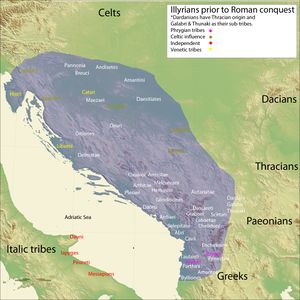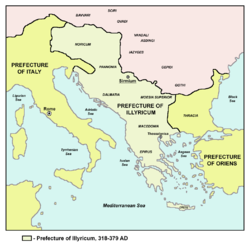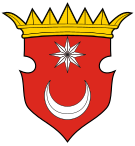إليريا
إليريا
Illyria | |
|---|---|
 المنطقة التقريبية التي استوطنها الإليريون في القدم. | |
| الإقليم | جنوب شرق أوروپا |
| المنطقة | غرب البلقان |
في القدم الكلاسيكي، إليريا (باليونانية قديمة: Ἰλλυρία أو Ἰλλυρίς،[1] لاتينية: Illyria،[2] انظر أيضاً إليريكوم) كانت منطقة في الجزء الغربي من شبه جزيرة البلقان يقطنها الإليريون.
قبل التاريخ لإليريا والإليريين معروف من قرائن أثرية. وقد فتح الرومان المنطقة في 168 ق.م. في أعقاب الحروب الإليرية. "إليريا" لذلك هي توصيف لمنطقة معرّفة بالتقريب في غرب البلقان من وجهة نظر رومانية، تماماً مثلما أن ماگنا گرمانيا هي مصطلح جغرافي تقريبي لا علاقة له بالكيان اللغوي أو العرقي.
المصطلح إليريس Illyris يُستخدم أحياناً لتعريف منطقة (الآن في ألبانيا المعاصرة) شمال وادي آوس مثل إليريس گريكا Illyris Graeca.[3]
أصل الاسم
في الأساطير اليونانية، اسم "إليريا Illyria" يمكن تتبعه إلى إليريوس، ابن قدموس و هارمونيا، الذي حكم إليريا وأصبح السلف الذي منح اسمه لشعبها، الإليريين.[4] وثمة نسخة لاحقة من الأسطورة تحدد پوليفيموس و گلاتيا كوالدي كلتوس، گلس و إليريوس.[5]
استخدم الكتاب اليونانيون القدماء الاسم "إليريون" لوصف الشعوب بين الليبورني و إپيروس.[6] الكتاب اليونانيون في القرن الرابع ق.م. فصلوا بشكل واضح الشعب على طول ساحل الأدرياتي عن الإليريين، وفقط في القرن الأول الميلادي اِستُخدِم تعبير "الإليريون" ليصف كل الشعوب عبر الأدرياتي.[7] كما تكلم الكتاب عن "الإليريين بالمعني الضيق للكلمة"؛ Pomponius Mela (43 AD) the stricto sensu Illyrians lived north of the Taulantii and Enchele, on the Adriatic shore;[8] استخدم پلني الأكبر اسم "الإليريين المسمون بدقة"[7] (Illyrii proprii/proprie dicti) لشعب صغير[7] جنوب إپيدورم,[7] أو بين إپيدورم (الآن كاڤتات) و ليسوس (الآن لجا).[8] وفي الفترة الرومانية، إليريكم كانت مستخدمة للمنطقة بين الأدرياتي والدانوب.[6] [9]
الممالك
The earliest recorded Illyrian kingdom was that of the Enchele in the 8th century BC.[10] The era in which we observe other Illyrian kingdoms begins approximately at 400 BC and ends at 167 BC.[11] The Autariatae under Pleurias (337 BC) were considered to have been a kingdom.[12] The Kingdom of the Ardiaei began at 230 BC and ended at 167 BC.[13] The most notable Illyrian kingdoms and dynasties were those of Bardyllis of the Dardani and of Agron of the Ardiaei who created the last and best-known Illyrian kingdom.[14] Agron ruled over the Ardiaei and had extended his rule to other tribes as well.[15] As for the Dardanians, they always had separate domains from the rest of the Illyrians.[16]
The Illyrian kingdoms were composed of small areas within the region of Illyria. Only the Romans ruled the entire region. The internal organization of the south Illyrian kingdoms points to imitation of their neighbouring Greek kingdoms and influence from the Greek and Hellenistic world in the growth of their urban centres.[17] Polybius gives as an image of society within an Illyrian kingdom as peasant infantry fought under aristocrats which he calls in Greek Polydynastae (Greek: Πολυδυνάστες) where each one controlled a town within the kingdom.[18] The monarchy was established on hereditary lines and Illyrian rulers used marriages as a means of alliance with other powers.[19] Pliny (23–79 AD) writes that the people that formed the nucleus of the Illyrian kingdom were 'Illyrians proper' or Illyrii Proprie Dicti.[20] They were the Taulantii, the Pleraei, the Endirudini, Sasaei, Grabaei and the Labeatae. These later joined to form the Docleatae.
الحكم الروماني والبيزنطي
The Romans defeated Gentius, the last king of Illyria, at Scodra (in present-day Albania) in 168 BC and captured him, bringing him to Rome in 165 BC. Four client-republics were set up, which were in fact ruled by Rome. Later, the region was directly governed by Rome and organized as a province, with Scodra as its capital.
The Roman province of Illyricum replaced the formerly independent kingdom of Illyria. It stretched from the Drilon river in modern Albania to Istria (Croatia) in the west and to the Sava river (Bosnia and Herzegovina) in the north. Salona (near modern Split in Croatia) functioned as its capital.
After subduing a troublesome revolt of Pannonians and Daesitiates, Roman administrators dissolved the province of Illyricum and divided its lands between the new provinces of Pannonia in the north and Dalmatia in the south. Although this division occurred in 10 AD, the term Illyria remained in use in Late Latin and throughout the medieval period. After the division of the Roman Empire, the bishops of Thessalonica appointed papal vicars for Illyricum. The first of these vicars is said to have been Bishop Acholius or Ascholius (died 383 or 384), the friend of St. Basil. In the 5th century, the bishops of Illyria withdrew from communion with Rome, without attaching themselves to Constantinople, and remained for a time independent, but in 515, forty Illyrian bishops renewed their loyalty to Rome by declaring allegiance to Pope Hormisdas. The patriarchs of Constantinople succeeded in bringing Illyria under their jurisdiction in the 8th century.[21]
ذكراها
The name Illyria only disappears from the historical record after the Ottoman expansion into the Balkans in the 15th century, and re-emerges in the 17th century, acquiring a new significance in the Ottoman–Habsburg Wars, as Leopold I designated as the "Illyrian nation" the South Slavs in Hungarian territory.[21] The term "Illyrian" was sometimes used for the language they spoke. Several armorials of the Early modern period, popularly called the "Illyrian Armorials", depicted fictional coats of arms of Illyria.
The name Illyria was revived by Napoleon for the Illyrian Provinces that were incorporated into the French Empire from 1809 to 1813, and the Kingdom of Illyria (1816–1849) was part of Austria until 1849, after which time it was not used in the reorganised Austro-Hungarian Empire.
The Illyrian movement was a South Slavic cultural and political campaign by a group of young Croatian intellectuals during the first half of the 19th century, that led to Yugoslavism.
انظر أيضاً
- دلماتيا
- أبرشية إليريكوم
- تاريخ البلقان
- المقاطعات الإليرية
- القتال الإليري
- مملكة إليريا (1816–1849)
- مقاطعة إليريكوم الپريتورية
- مقاطعة إليريكوم الرومانية
المراجع
الهامش
- ^ پوليبيوس. Histories, 1.13.1.
- ^ Lewis, Charlton T.; Short, Charles. "Illyria". A Latin Dictionary.؛ إنگليزية: Illyria؛
- ^ Boardman 1982, p. 623.
- ^ Grimal & Maxwell-Hyslop 1996, p. 230.
- ^ Grimal & Maxwell-Hyslop 1996, p. 168
- ^ أ ب Wilkes 1969, p. 5.
- ^ أ ب ت ث Wilkes 1969, p. 161.
- ^ أ ب Radoslav Katicic (1 January 1976). Ancient Languages of the Balkans. Walter de Gruyter. pp. 158–. ISBN 978-3-11-156887-4.
- ^ Marjeta Šašel Kos (2005). Appian and Illyricum. Narodni Muzej Slovenije. p. 231. ISBN 978-961-6169-36-3.
- ^ Stipčević 2002.
- ^ Wilkes 1995, p. 298.
- ^ Lewis & Boardman 1994, p. 785.
- ^ Wilkes 1969, p. 13.
- ^ Kipfer 2000, p. 251.
- ^ Hammond 1993, p. 104.
- ^ Papazoglu 1978, p. 216.
- ^ Wilkes 1995, p. 237.
- ^ Wilkes 1995, p. 127.
- ^ Wilkes 1995, p. 167.
- ^ Wilkes 1995, p. 216.
- ^ أ ب Lins 1910, "Illyria".
المصادر
- Berranger, Danièle; Cabanes, Pierre; Berranger-Auserve, Danièle (2007). Épire, Illyrie, Macédoine: Mélanges Offerts au Professeur Pierre Cabanes. Clermont-Ferrand, France: Presses Universitaires Blaise Pascal. ISBN 2-84516-351-7.
{{cite book}}: Invalid|ref=harv(help) - Boardman, John (1982). The Prehistory of the Balkans and the Middle East and the Aegean World, Tenth to Eighth Centuries B.C. Cambridge, United Kingdom: Cambridge University Press. ISBN 0-521-22496-9.
{{cite book}}: Invalid|ref=harv(help) - du Fresne, Charles (1746). Illyricvm Vetvs & Novum: Sive Historia Regnorvm Dalmatiae, Croatiae, Slavoniae, Bosniae, Serviae, atqve Bvlgariae. Posonii: Typis Haeredvm Royerianorvm.
{{cite book}}: Invalid|ref=harv(help) - Grimal, Pierre; Maxwell-Hyslop, A. R. (1996). The Dictionary of Classical Mythology. Oxford, United Kingdom: Blackwell Publishing Limited. ISBN 0-631-20102-5.
{{cite book}}: Invalid|ref=harv(help) - Hammond, Nicholas Geoffrey Lemprière (1993). Studies concerning Epirus and Macedonia before Alexander. Amsterdam, The Netherlands: Adolf M. Hakkert.
{{cite book}}: Invalid|ref=harv(help) - Kipfer, Barbara Ann (2000). Encyclopedic Dictionary of Archaeology. New York, New York: Kluwer Academic/Plenum Publishers. ISBN 0-306-46158-7.
{{cite book}}: Invalid|ref=harv(help) - Lewis, David Malcolm; Boardman, John (1994). The Cambridge Ancient History, Volume 6: The Fourth Century BC. Cambridge, United Kingdom: Cambridge University Press. ISBN 0-521-23348-8.
{{cite book}}: Invalid|ref=harv(help) - Lins, Joseph (1910). "Illyria". The Catholic Encyclopedia, Volume 7. New York, New York: Robert Appleton Company.
{{cite book}}: Invalid|ref=harv(help) - Papazoglu, Fanula (1978). The Central Balkan Tribes in Pre-Roman Times: Triballi, Autariatae, Dardanians, Scordisci and Moesians. Amsterdam, The Netherlands: Adolf M. Hakkert. ISBN 90-256-0793-4.
{{cite book}}: Invalid|ref=harv(help) - Stipčević, Aleksandar (2002). Ilirët: Historia, Jeta, Kultura, Simbolet e Kultit. Tirana, Albania: Toena. ISBN 99927-1-609-6.
{{cite book}}: Invalid|ref=harv(help) - Wilkes, John J. (1969). History of the Provinces of the Roman Empire. London, United Kingdom: Routledge and Kegan Paul.
{{cite book}}: Invalid|ref=harv(help) - Wilkes, John J. (1995). The Illyrians. Oxford, United Kingdom: Blackwell Publishers Limited. ISBN 0-631-19807-5.
{{cite book}}: Invalid|ref=harv(help)
- Articles containing إنگليزية-language text
- Pages using Lang-xx templates
- Short description is different from Wikidata
- Pages using infobox settlement with unknown parameters
- Pages using infobox settlement with no coordinates
- Articles containing Ancient Greek (to 1453)-language text
- Articles containing لاتينية-language text
- Articles with hatnote templates targeting a nonexistent page
- إليريا
- اليونان القديمة
- تاريخ اليونان
- تاريخ ألبانيا
- تاريخ سلوڤنيا
- تاريخ دلماتيا
- تاريخ البوسنة والهرسك
- قبائل قديمة في البوسنة والهرسك
- تاريخ الجبل الأسود

